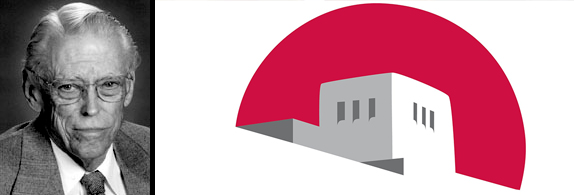Van Dorn Hooker and UNM

Van Dorn Hooker still owns an l950s era Studebaker. It sits in his Corrales driveway. Elegant design is never out of date. Nor is a visionary.
Not many really know all that much about Van Dorn any more. He’s too self-effacing and too generous for fame. And yet his name should be synonymous with one of New Mexico’s most eloquent human achievements in modern times – the graceful continuity of the University of New Mexico’s central campus.
Tall and lean, and ever courtly, Van Dorn’s smile could disarm a polecat or, in his day, a UNM regent. He’s a man of few words, and many words at once. At almost 92, he’s still a great conversationalist, who chooses his words and sentences with discretion. And he’s finishing up yet another major book project on the architectural environment at the University of New Mexico. This one deciphers and explains all the names on all the buildings, benches, fountains, gardens, and other features on campus. His great book, Only In New Mexico, chronicles the architectural history of UNM.
The UNM central campus is by many reckonings among the great regional style campus precincts in the country, and the only one devoted to evoking indigenous Native American and Hispanic architectural traditions. As Richard Dober, an international planning authority, has remarked, “I think there are some benchmarks that campus planners might study to their benefit….For continuity of campus design: the University of Chicago, the University of Colorado, Harvard Yard, the University of Miami, the University of New Mexico, and the University of Virginia.”
That’s good company. And Van Dorn Hooker is the man who made it happen.
UNM has had two great architectural eras, one associated with John Gaw Meem and his regional Spanish Pueblo style aesthetic in the l930s, and the other encompassing the years 1963 to 1987, the years of Van Dorn Hooker’s tenure as University Architect.
Hooker oversaw the transformation of UNM’s campus from a beloved period of Romantic Regionalism to one in which historical buildings and modernist buildings could coexist with continuity, to borrow Dober’s term, and in harmony with the spirit of our state.
In the introduction to Only In New Mexico, Hooker wrote “In order to maintain that continuity I required every architectural firm employed to design a major project to build a model of the proposed building and, in most cases to include at least the facades of the neighboring buildings. I resisted developing a manual of style and told architects they must respect the campus and do the best job they had ever done. I learned to say “no” to designs that seemed inappropriate.”
Melissa Howard, long time New Mexico editor and writer, observed in her preface to Only in New Mexico that between 1963 and l987, when Van Dorn retired, some seventy five major buildings, additions, and remodelings were completed…. Campus architecture was redefined to including landscaping, historic preservation, and facility planning, as well as parking, energy conservation, artwork, handicap access, capital funding security and interior design. The classic Pueblo Style was adapted to accommodate the modern idiom and the demands of size and technology….The University received more than thirty design awards for architecture and landscaping during Hooker’s twenty four years – and thousands more students fell under the spell of New Mexico.”
In the forward to Only in New Mexico, I wrote that Van Dorn “managed to reconcile at UNM a regional style grounded in vernacular architecture with functionalist concerns by guiding the architects UNM commissioned….to allow modernist geometric forms to reflect the New Mexico cultural milieu. This he achieved largely through the use of earth colors, modularization, and evocative shapes that did not confront or offend the functionalist abhorrence of decoration.”
Van Dorn Hooker believed in honoring context. He respected New Mexico, he respected the dozens of gifted architects who lived and work here, he respected history, and he worked tirelessly for the students who would build the future.
His great gift to all of us is a campus that is so serene, so of its place, and so beautiful to be in that the young and old alike feel respected, themselves, just by being there. For me that’s Van Dorn Hooker’s great legacy. His life and work are an example of what appreciation, admiration of tradition, and the embracing of innovation can achieve. Van Dorn Hooker’s genius was about inclusiveness and how to allow differences to co-exist and ennoble each other.
Water Numbers in Albuquerque and Sin City

Patricia Mulroy, General Manager of the Southern Nevada Water Authority, and, because of her political acumen, one of the most powerful people in the water world of the American West, pulled a number from her batch of statistics to crow about Las Vegas’s conservation efforts, saying it had brought its residential water usage down to 75 gallons per person per day.
This isn’t just a dry statistic, no pun intended. Because water conservation is key to the economic survival of western cities that can’t get any more water than they already have, how much their people use a day is vitally important.
But residential use is a category that water authorities don’t refer to very often. They like to talk about overall, not residential, gallons used per capita per day (GPCD). But I bet that most people think that overall GPCD means per person use, not overall use. Why? Because per capita means “per person” and implies average use per person.
The Albuquerque Bernalillo County Water Utility Authority (ABCWUA) doesn’t publicize its residential use statistics because they think it would be too confusing.
If they did, it would show Albuquerque’s residential use at 69 gallons per person per day. That’s six whole gallons less a day than Las Vegas, or about three or four flushes of a high efficiency toilet or one flush of some older, non-efficient ones.
No wonder ABCWUA doesn’t play up that number. A few flushes a day away from the usage of one of the mightiest water guzzling cities in the west isn’t something to write home about.
When you compare overall usage, Albuquerque appears to be way ahead – 148 GPCD to 222 GPCD in Las Vegas.
Here’s where the confusion really sets in. When you say that Albuquerque used 148 gallons of water per person per year last year, and Las Vegas used 222 gallons of water per person per year last year, it looks like you’re comparing apples to apples.
But, strictly speaking, you’re not. That overall number is not a per capita, or a per person number, at all. It’s a hodgepodge number, made up of residential usage and all other usages, including business, manufacturing, government properties, universities, casinos, parks, the whole shebang.
So while actual humans in Albuquerque and Las Vegas use about the same amount of water per person a day a year so far, the rest of the usage is all mixed up with apples, oranges and pear and kumquats.
Businesses, parks, and casinos are not persons, are not comparable units to one another, but rather comprise a vast, statistical pot of mixed uses. It would be like comparing ponies to Clydesdales, and Clydesdales to cattle. They all use water but are not in the same league, or the same category, at all.
When you compare our residential use with theirs, it means something.
But when you compare our hotels, our casinos, our infrastructure, or anything else, it’s like comparing mice and elephants. Surely our hotels and casinos use incredibly less water than theirs, because there are far fewer of them, and ours are far, far smaller. The units are not comparable.
I believe that most of us in Albuquerque still think that our overall usage is our residential usage, because water numbers are calculated misleadingly as per capita figures, but in the overall picture they are not per person. They are per person, per business, per park, and so on.
Why does this matter? Many of us are scrupulous to the point of fanaticism about our water use. We try and try to use less and less. But when we’re lumped in with businesses and hotels and the like, which I am sure are not anywhere near as water scrupulous as we are, we can’t tell how we are doing. We’re forced to compare apples to oranges.
And to top it off, our bill from the ABCWUA tells us how many gallons our household uses a month, but doesn’t say anything about our per capita usage per month. Is our household a person? Or are we? And how does that distinction figure into the big statistical picture? And our water bill further muddies the waters of conservation with weird numbers like “usage units,” which appear nowhere else in water world statistics that I can find. Our water bills also come with an odd chart that is a month behind but which compares our usage [our household’s I presume] and the “Residential Average Usage” for which no numbers or timeframe are given.
Basically we’re comparing apples and oranges all over the place. And folks are confused. I know everyone’s trying hard to make sense of all this. But it might help if the ABCWUA could use consistent units of measurement and stop using language that doesn’t really mean what it says – per capita is an average per person, not per household, per hotel, per casino, or per dog and cat in residence.
Until the numbers are straight, it’s hard to tell just how well we are doing and how much water we still must work to conserve as a city, a household, and as individual, per capita persons. Maybe residential use would be the most useful number to trumpet. Or perhaps the ABCWUA could also break the numbers down into business usage(still too large and vague a category), manufacturing usage, and public/governmental usage.
Most of us are trying to do our bit. Clear numbers would make it easier.
BEMP

What an experience! To be a young person teamed up with scientists, university student interns, and community water experts as part of a many-year-long project of carefully examining the condition of Rio Grande Bosque, collecting data on its wildlife, the ebb and flow of its water table, and so much more -- I wish I’d had something like that when I was a kid.
That’s what the Bosque Ecosystem Monitoring Program (BEMP) is all about. As its motto says: “Science, Education, and Stewardship.” It gives children the opportunity to do real science in the service of protecting one of our state’s most treasured resources and to educate themselves, with the help of many teachers and volunteers, in the principles of ecology and the realities of the amazing riparian ecosystem that is our Bosque.
A few years back I was at the National Hispanic Cultural Center and was invited to meet a team of young people monitoring the Bosque there. Kids of many ages were as engrossed and serious as any professional, helping each other with their measurements, alert to tiny changes, proud of their work, fascinated by the majesty of the river. Their enthusiasm was expansive and I left them feeling that rare sensation that everything’s right with the world, at least on that sunny day.
A BEMP report of 2009 described the action, saying “Certain elements of science and math are made more tangible and understandable in practice than through reading about them or listening to a lecture. How better to understand the water cycle than to monitor monthly rainfall levels… or seeing low, baseline river flows spike into high fast flows after rainstorms; or by melting snow in rain gauges to record accurate precipitation throughout the winter, and then recording the high water table levels and river’s flow after snowmelt in the spring?”
Before participating in BEMP, the report continues, “many of these youngsters…had never been to the bosque. By the end of the year, those same newcomers can show you around their site, pointing to a spot where they once found porcupine tracks; where they saw a lizard eating bugs out of a pitfall trap; which litterfall tubs have ant nests beneath them, and where the best spots are for sitting and drawing. This sense of ownership/stewardship/belonging to the land that many of us take for granted is sadly lacking for many youngsters of today. Fostering this sense of stewardship in people is one of the key goals of BEMP.”
The majority of BEMP’s data collection is done by students and teachers (with associated BEMP staff or UNM student interns) from kindergarten through the twelfth grade. The whole project is mainly a partnership between UNM and the Bosque School and in collaboration with many other programs and state, federal and county agencies including the Long Term Ecological Research Schoolyard/Sevilleta National Wildlife Refuge.
BEMP has some 25 monitoring sites along 140 miles of the Rio Grande and involves more than 5,000 young people and their learning friends and teachers. BEMP has data now on “post-fire, post-clearing, and landscape lowering effects” on plant life and groundwater recovery over nearly 16 years of observation. How lucky we are to have educators who know how to engage young people in such a serious and, I’m sure, joyous and fascinating way.
I’ll always look at the Bosque with a new sense of security and relief, and know it’s in the strong, good hands of youngsters who care about the world around them, and who are being taught, by opened-minded generous adults, all the best ways to do that.
State Fair Fun

The water war between New Mexico and Texas is a long, long war. The first time I went to the New Mexico State Fair it was at night in l958. We’d found some beer, and so eventually needed the gents. On the wall above us were signs, unofficial as I remember, that said “Flush the Toilet. Texas Needs Water.” It was the same in the ladies, I’ve been told. So my first experience of this marvelous circus of fun was highlighted by a struggle over the Rio Pecos and the Rio Grande going full blast in popular culture 55 years ago written small in ball point pen over a flusher.
But the fun doesn’t stop there.
Recently I had the distinct honor and privilege to be one of the judges at the State Fair Karo Syrup baking contest, the only male, and only non-baker in the huddle of tasters. When I was asked to do this, I mentioned that I had no expertise in baking at all, except that I loved to eat cakes and cookies and pies. I was inducted immediately into the elite corps of inspectors and lip smackers and given an apron with KARO on it. I was humbled.
My fellow judges knew exactly what they were doing. I, ever the innocent, slurped and scooped and ogled the pies and cakes and icing like a 7 year old. I didn’t know that the audience watching the judging was made up of the bakers and their families. I came close to hurting feelings with injudicious smirks and eye rolls. But gusto saved the day. Smiles beamed all around. The cakes and pies and brownies were all verging on the divine. And the winners won tight races as the four judges sampled their way through perhaps 45 or 50 entries and palette cleansings. It was a time to remember.
So was the afternoon when I spent a couple of hours watching a dozen older gentlemen pitching horseshoes, a pastime I’d indulged in on many an afternoon over many a cold beer in our garden. I had an amateur’s delight in watching real pros at work. A ringer to me was gift from Zeus. For these guy, not making a ringer was a curse from the underworld. They just “never” missed. It was astounding, clanging ringer after clanging ringer, smooth gliding arm action one pitch after another. Mesmerizing. When someone missed, groans and “oh gees” filled the air.
The winner won because, at least while I was watching, he never missed, never once. It must have been sort of regular for him. No high fives, no jumping for joy. He just put on his jacket, collected his horse shoes, wished everyone a good evening, and ambled off into the twilight.
My favorite times at the fair, when I left the Home Economy building with cookies in pocket, were going to see former Governor Tom Bolack’s display of his bountiful harvests from his Farmington garden. A big game hunter, an oilman, an election code reformer, Bolack also had a prodigious green thumb. The man could grow melons and squash the size of dangerous asteroids, and his corn and tomatoes and beans and herbs flowed from cornucopias. In the l960s I had the pleasure of going to his ranch on a Chamber of Commerce junket for the Albuquerque Tribune, and sat in the big, overstuffed living room chair with the much bigger overstuffed Kodiak bear rearing up behind it. Bolack had been detained by business that day and made his appearance with rolled up maps under his arm and spattered in oil. He’d just struck it rich again with a nice little geyser and looked sort of sheepish and embarrassed for being late.
Just across the way from Bolack’s vegetable pleasures were the sheep pens, with shorn little fellas wearing blue sweats and hoodies to keep themselves warm in the cool of the evening. And nearby were massive hogs slumbering in their utopias of grain and straw. One of the hog owners asked me once if I wanted to see them move, and I said “sure, why not.” She walked over to the biggest one, made a fist and slugged it in the rump. It mumbled under its breath and slouched an inch to the left.
I felt guilty and left before it looked me in the eye.
(Photo credits: Bellagio fountains by Sarah Ackerman, Balloon over the Rio Grande by mnchilemom and cherry pie by Madame Meow.)




Responses to “Provincial Matters, 9-9-2013”